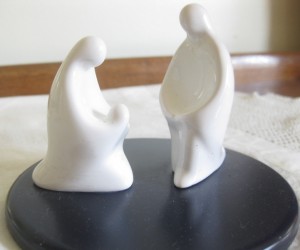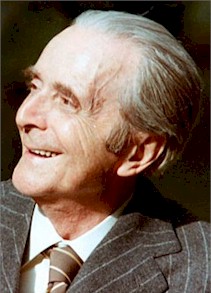Mary, the Mother of Jesus:
Posted by SociusMay 16
The word ‘Gospel’ means good news. But how do I explain this good news to myself, and to others around me? It seems a very difficult task in today’s world.
Last week Socius sent me his short blog on Mary, wondering if what he wrote was adequate. I was enchanted by what I read. The writing was the result of what happened. He had taken hold of his Miraculous Medal in a low moment, and out came the words from the heart. One phrase struck me deeply: ‘Mary is so holy – so pure – so feminine – so motherly –so helpful – so considerate of all of us, wih our puny problems.’
All my life Mary has been an important protector, a loving presence, a person to venerate and love, a close friend. I thank God for some of the films I have seen that are about the birth of Jesus: they give me a picture of this person whom I love. I have, however, often struggled with devotional statues of Our Lady, or devotional pictures. They seemed to take my Mary away, rather than enhance her – except when they are very simple and straight forward, or of outstanding artistic quality.
 |
Nativity scene that does appeal to my artistic sense
I have on two occasions in my life been to Nazareth. It is now a sprawling modern town of 75,000 inhabitants. In the time of Mary, Joseph and Jesus, it might have mustered 100 or so. I was struck by the fact that the traditional home of Mary lies about half a mile from the only water supply in that hamlet of old, and I could imagine Mary, each day, walking for water; I can imagine a strong, sturdy girl, used to hard work of all kinds, as well as being a mother, and constant support of Jesus. I imagine that Joseph died, probably, when Jesus was about 16 or so. Of course, I know from my faith, that she is the perfect disciple of Jesus, the model of what each Christian should be, the Icon of the Church and each of its members.
The 17th September 1948 is not remarkable as an important date in any worldly sense. However, it was important for a famous Italian writer called Igino Giordani, and for many others that he influenced. He was a Catholic apologist, forced to live in the safety of the Vatican during the Second World War, to avoid arrest from the Nazi’s and the Italian Fascists. The date I point to was the day of his conversion to a real Christianity, after years of a full Christian life. He was, in fact, an MP in the post-war Italian Parliament by this time. The following paragraph is how he describes his change of heart when Chiara Lubich came to visit him, at the Parliament building in Rome.
“She showed me a new Christianity. Yes, I knew a lot, I felt I was a teacher in Israel, I had written fifty books at least, some translated even in Chinese, Japanese and the Malay language etc. But I discovered there something new; I found that I did know the externals, the doctrine, the history of the Church but I had no understanding of the mystical side what went on within, a spiritual life with God. I had been transformed. I remember that some months later the President of the Senate commented on what he observed: “Giordani, what has happened to you? I no longer recognise you; your writing is no more as it used to be”, because I had been aggressive etc. I used to slate heretics, I was a sledge hammer to destroy them. Chiara told me that I must cover heretics with a mantle. He exclaimed; “I no longer recognise you, whatever has happened?” What had happened was that I had discovered Chiara’s genuine Christianity of the Gospel, much stronger than mine.”
On the first of October 1957, nine years later, another event – like that of Socius and the Miraculous Medal – happened to Igino Giordani, in regards to Mary. This is how he described what happened.
“I was meditating on the mystery of suffering, on the evening of October first, a month sacred to Mary. After prayers, all of a sudden my soul was cleared of human things and persons and in their place Mary entered, together with Jesus who had died, all the blood gone out of him. My soul was filled by her figure of suffering and of love. And with her living in me I grasped the frivolity of my attachment to transient things. This lasted for twenty-four hours. She was there, like an altar holding the victim: My soul was her abode, her temple. But at the end of twenty-four hours, sharing in her anguish and love for her brought about a unity between her and my soul: she was no longer my guest, but I was her guest, so that I could say: `It is no longer I who live but Mary who lives in me.’
“Her presence had, as it were, completely purified my soul; my person had been infused by Mary. My ego seemed to be dead, and in its place Mary was born so that I no longer felt the need to raise my eyes to the street shrines or to statues of Our Lady; it was enough and it is enough for me to turn the gaze of my soul within myself, to discern in the place of the usual grimy and grotesque idol of myself, the All Beautiful One, the Mother of fairest Love. And even this poor, suffering body seems to me to have become a sort of cathedral, where Mary, with the lifeless Jesus, summons the Bridegroom, who in turn assembles the Trinity.
Unless I am the most utter scoundrel I must become a Saint, to be in harmony with this reality.”
 |
Igino Giordani in his old age.
(The Bishop of Frascati has begun his cause for beatification)
What I like about this description is that it corresponds to my own experience. It is not helpful for me only to venerate statues, or pictures, of Mary and to feel devotion to her through these images. In fact, the images and statues, for me, sometimes do the opposite; they distract rather than help. For me, what makes sense is to try to let her spirit live in me, to see things with her eyes, to have her way of looking at people, to try always to see the good in others – especially those who are far away from the presence of God – and, through her, to try to witness to the wonderful Good News that is the Gospel. Writing to Fr. Bonaventure, a Cappuchin who, like me, is somebody deeply influenced by the ‘Charism of Unity’, Chiara Lubich, on 11 May 1948, penned something of her Gospel understanding, that could be liberating to everyone.
 |
“I tell you one thing: the Ideal we’ve embraced is God: Unity-Trinity and so it’s as ineffable as infinite and eternal Love. And because of this, it’s immanent, present (as God) even in the tiniest things, even in the smallest events!
Even from the evil we commit (the only thing that is truly ours), he is able to draw greater good than the good that the evil has taken away.”
Fr. Bonaventure in his 93rd year in January 2013.
If I wanted to explain the Good News of the Gospel to people around me today, and to my own self, too, this last sentence of Chiara’s is the one that explains it best to me. It is what the mild and inoffensive – but real spirit of Our Lady – would say.
Fr. Jonathan

No comments